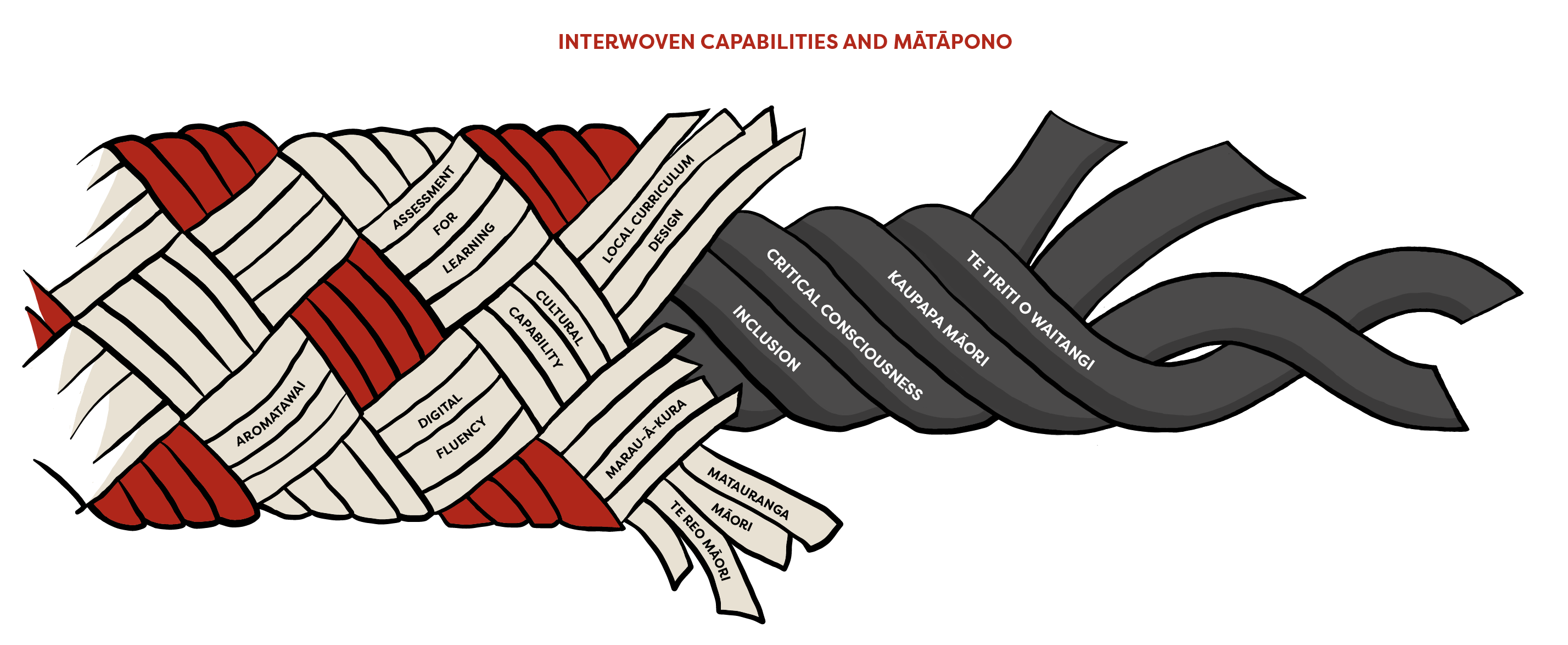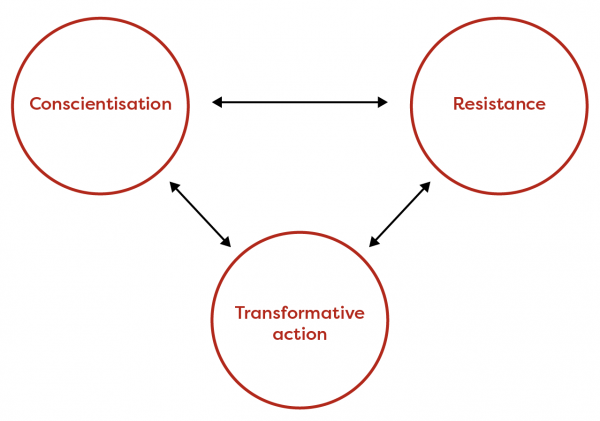Te whāinga o ngā whakaarotau
The intent of the priorities
Ngā hua o te mahi tahi | Collective impact 
The kaupapa for this mahi was crafted by a development team of tumuaki and manutaki at a wānanga at Huria Marae – it informs the capabilities and expresses their purpose.
Whether we are tangata whenua or tangata tiriti, we all have an obligation to actualise Te Tiriti o Waitangi so that mana ōrite for both partners will be upheld. For this reason, regionally allocated professional learning in Aotearoa will operate as a lever for transformative change that seeks to eliminate racism, discrimination and bias, return rangatiratanga, and strengthen equity. The design of regionally allocated professional learning will be built upon the principles of kaupapa Māori to ensure mana-enhancing experiences for all tamariki-mokopuna and whānau. All tangata whenua or tangata tiriti involved in education can take transformative action to create a future Aotearoa in which our tamariki-mokopuna feel they belong and can flourish.
Mauri ora!
Tō mātou kaupapa mō te huringa me ngā āheinga | Our kaupapa for transformation and the capabilities
The kaupapa expresses the moral purpose and motivation for the capabilities.
The shift towards integrated capabilities within PLD is part of work that is underway across the system. But is it enough? The kaupapa calls for transformative change:
- …regionally allocated professional learning in Aotearoa, as a lever for transformative change, will eliminate racism, discrimination and bias, return rangatiratanga, and strengthen equity.
Capabilities are about knowledge and skills. Even if joined-up and better connected to local priorities within local contexts, they are unlikely to be transformative in themselves.
Transformative action starts with moving beyond knowledge and skills to the assumptions, values, theories, and beliefs that inform our thinking about how we teach ākonga in our particular place.
This mahi, when thought about as the act of “Whiria te taura tangata, to weave the rope of the people”, is the work of tightening the taura and strengthening the collective capabilities of education in New Zealand. This requires cycles of professional growth and evaluative capability. These cycles will help us explore alternative perspectives through alternative cultural realities. This will re-orientate our relationships and challenge the conditions that hold racism, discrimination, and bias in place. Together we can learn to build on the strengths and aspirations of tamariki-mokopuna, their whānau and communities, and all who care for them.
Taking transformative action in a kaupapa Māori context
In Western traditions it is assumed that people get to transformative action by moving in a linear fashion from conscientisation (thinking critically about the status quo) to resistance (taking action to bring about change). This diagram was first presented by Professor Graham Hingangaroa Smith, who uses examples of kaupapa Māori interventions to show that for Māori and other indigenous people, these elements are interrelated and don’t follow a set sequence.
Whakaritea i te kaupapa: Whakaaetanga mai o te akoranga | Implementing the kaupapa: Conscious acts of teaching
Conscious acts of teaching offer us a way to realise the kaupapa through the capabilities. Each capability is associated with values, practices, and knowledge that evidence shows improve educational experiences for tamariki-mokopuna. The capabilities intertwine and overlap. They come together as conscious acts of teaching, such as those described by this diagram.

Download a copy of Interwoven capabilities and mātāpono
|
You are likely to be more familiar with the term “deliberate acts of teaching”. We have chosen to use the word “conscious” because of its resonance with the critical consciousness mātāpono. |
Conscious acts of teaching are thoughtfully selected to have a specific impact on the learner. They are observable and defensible; the person making the decision can explain and justify their reasoning in relation to each ākonga. Conscious acts of teaching require:
- personal recognition of the biases we hold and their likely impact on ākonga and whānau
- deep understandings of each tamariki-mokopuna and of the purpose for learning
- genuine learning partnerships with ākonga, whānau, hapū, iwi, and communities that centre on the strengths, needs, and aspirations of ākonga
- practice that is both evidence-based and values-informed.
The kaupapa we have shared states that the ultimate purpose of education is to uphold mana and to return rangatiratanga. This means that for the actions and leadership of kaiako and tumuaki to be defensible as conscious acts of teaching, we should all strive and support each other to:
- actively engage with the aspirations set out in the the kaupapa and the underpinning principles of Te Tiriti, kaupapa Māori, inclusion, and critical consciousness
- shift power to whānau, hapū, iwi, and community so that they drive the discourse about the learning that matters for the identity and future of their children
- grow our ability to explain decision making in relation to individuals and groups of learners, selection of resources, using the language of our professional frameworks
- engage in repeated cycles of professional growth to take action and to evaluate the impact on ākonga and whānau.
Whakaritea i te kauapapa: Ngā mahi mā ngā manutaki me ngā tumuaki | Implementing the kaupapa: The task for manutaki and tumuaki
Being open to examining your beliefs and biases within teaching and learning is essential to implementing this kaupapa.
For manutaki and tumuaki, implementing the kaupapa means supporting capability building across the four priorities (curriculum design, cultural capability, assessment for learning, and digital fluency) using approaches that are underpinned by the principles of Te Tiriti o Waitangi, kaupapa Māori, inclusion, and critical consciousness. Manutaki and tumuaki can begin this mahi by exploring new questions, new kinds of evidence, and a wide range of perspectives.
The Ngā mātāpono and Ngā aheitanga resource kete include items to help you make sense of the new approach. You can use them to spark the critical thinking, conversation and inquiry that are vital for learning and profound change. Your work to understand and communicate the new approach to kaiako is the work of weaving the muka together.
As you explore the resource kete, remember to keep returning to the kaupapa. This will help you and your communities to question and debate your deepest beliefs about education in Aotearoa New Zealand.

